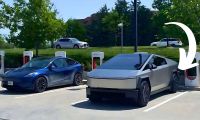First, did I mention I reshod my “all season” tires on new wheels (in quotes because all season tires aren’t the best tires for snow and ice slick roads)? What do you think, hot or not? To be honest, I bought them because of their price and because I thought they looked OK, and the fact they will pay for themselves in 7 or 8 years since I can now have them rotated, balanced, and mounted for free for life. Anyway, as I mentioned, my all electric range instantly increased from the low to mid 30’s on a charge to the upper 30’s due to the warmer weather and better rolling resistance of my tires.
Specifically, the first trip I took that allowed me to use up a full charge was 40 miles long. Here are the details of the drive: temperatures were in the upper 70’s to low 80’s Fahrenheit, I had 6 people and a small dog in the vehicle (which equates to somewhere around 900 lbs of weight in the car). The AC was running almost the entire time (stereo too), and my tires were inflated to 40 PSI, cold. The drive was about 75% on the freeway, with the rest on 25 - 45 MPH roads, and for about half of the time on the freeway we could not drive the speed limit due to traffic (so my average speed on the freeway was probably about 50 MPH). I managed to get a little over 38 miles on a full charge.
I knew that I was going to come up short on range and couldn’t make the whole trip on battery alone so I switched to hybrid (HEV) mode for exactly 3 miles and to my surprise, in those 3 miles (driving at about 60 MPH on the freeway) the gas engine heated up to its full operating temperature. I was not pushing the gas engine hard for any of the distance I covered (I was already at speed when I switched to HEV mode and other than one moderate hill the road was flat or gently sloping downhill). The 3 mins or so it took for the engine to fully heat up, during which it was basically running at idle, suggests good thermal efficiency in the Sorento PHEV. It is not simply due to better thermal efficiency (as engine size, the use a turbo, a CVT vs fixed gear transmission etc. all have impacts too), but this is one of the primary reasons I chose my Kia PHEV over rivals from Mitsubishi, Volvo, and Mazda (or I should say would have chosen it over Mazda since their CX-90 PHEV wasn’t available when I was shopping for my Kia). The Toyota Highlander HEV is similarly efficient, though it lacks a plug and as such only fulfills half its potential efficiency as a result. If Toyota ever works up the gumption to bring a Highlander PHEV to market, or Honda a Pilot PHEV, I would think that they could meet or beat Kia’s thermal efficiency. But for now at least, the Sorento PHEV is unmatched in its class.
Do you drive a PHEV and swap out winter and summer tires? If you don’t swap out your tires, I assume you might see a more gradual increase in efficiency as the weather warms up; is that accurate? Please leave any comments or questions below.
Image courtesy of Justin Hart.
Justin Hart has owned and driven electric vehicles for over 15 years, including a first generation Nissan LEAF, second generation Chevy Volt, Tesla Model 3, an electric bicycle and most recently a Kia Sorento PHEV. He is also an avid SUP rider, poet, photographer and wine lover. He enjoys taking long EV and PHEV road trips to beautiful and serene places with the people he loves. Follow Justin on Twitter for daily KIA EV news coverage.












